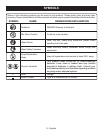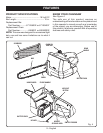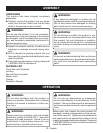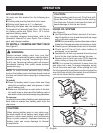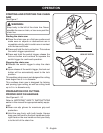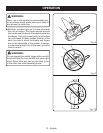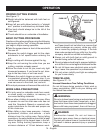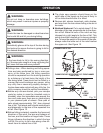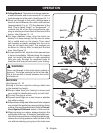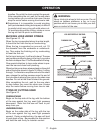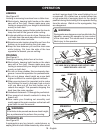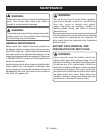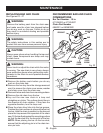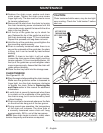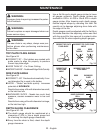
16 - English
Felling Backcut. The backcut is always made lev-
el and horizontal, and at a minimum of 2 in. above
the horizontal cut of the notch. See Figures 13 - 14.
Never cut through to the notch. Always leave a
band of wood between the notch and backcut
(approximately 2 in. or 1/10 the diameter of the
tree). This is called “hinge” or “hingewood.” It
controls the fall of the tree and prevents slip-
ping or twisting or shoot-back of the tree off the
stump. See Figures 13 - 14.
On large diameter trees, stop the back cut
before it is deep enough for the tree to either
fall or settle back on the stump. Then insert
soft wooden or plastic wedges into the cut so
they do not touch the chain. The wedges can
be driven in, little by little, to help jack the tree
over. See Figure 15.
As tree starts to fall, stop the chain saw and put
it down immediately. Retreat along the cleared
path, but watch the action in case something
falls your way. Be alert for overhead limbs or
branches that may fall and watch your footing.
WARNING:
Never cut through to the notch when making a
backcut. The hinge controls the fall of the tree,
this is the section of wood between the notch
and backcut.
BUCKING
See Figures 16 - 19.
Bucking is the term used for cutting a fallen tree
to the desired log length.
Always make sure your footing is secure and
your weight is distributed evenly on both feet.
Cut only one log at a time.
Support small logs on a saw horse or another
log while bucking.
Keep a clear cutting area. Make sure that no objects
can contact the guide bar nose and chain during
cutting, this can cause kickback. Refer to Precau-
tions Against Kickback earlier in this manual.
When bucking on a slope, always stand on the
uphill side of the log. To maintain complete con-
trol of the chain saw when cutting through the log,
release the cutting pressure near the end of the
cut without relaxing your grip on the chain saw
OPERATION
NOTCH
BACK CUT
Fig. 15
Fig. 14
KICKBACK
Fig. 16
HINGE
wEDGE
Fig. 17



